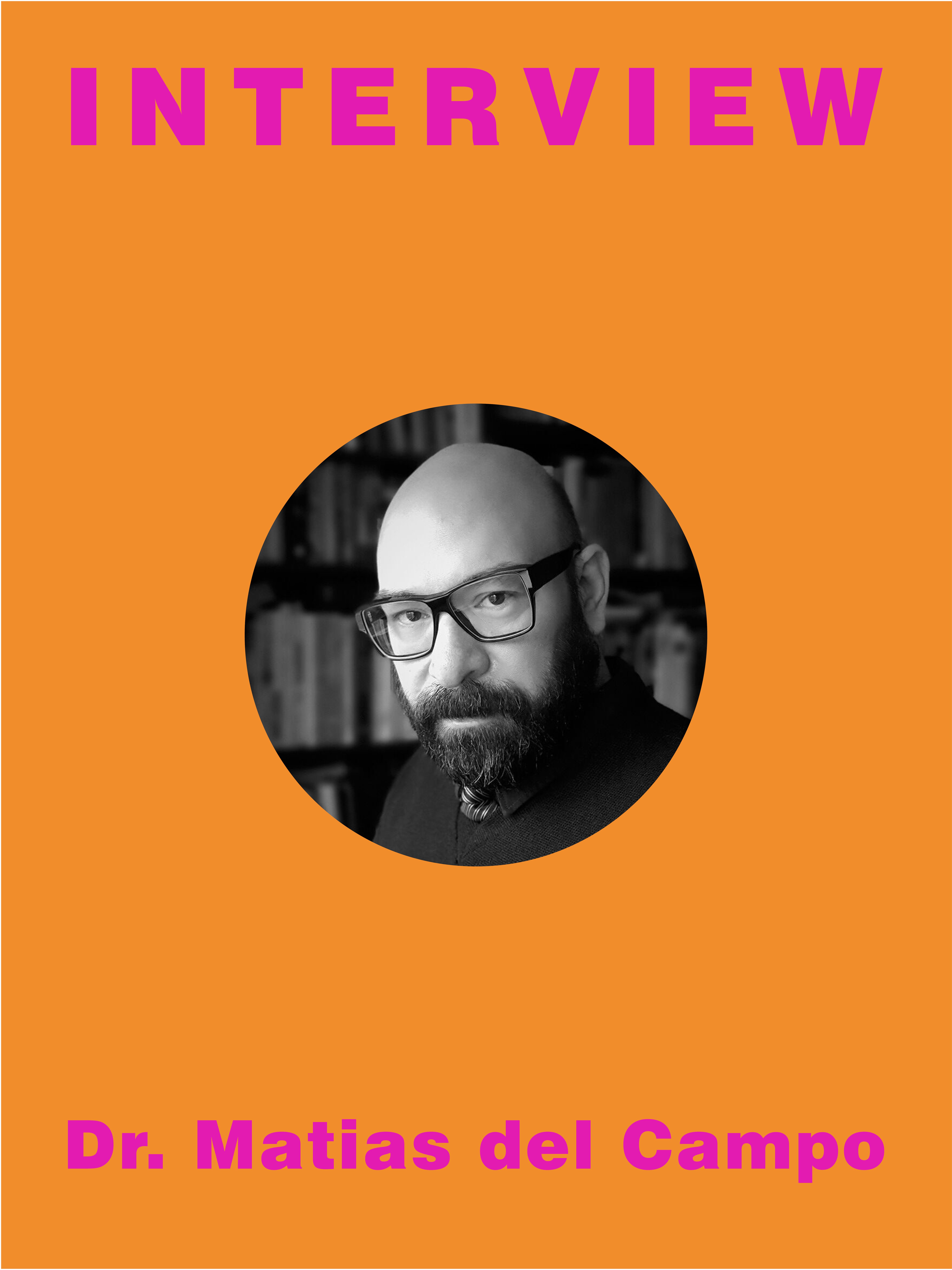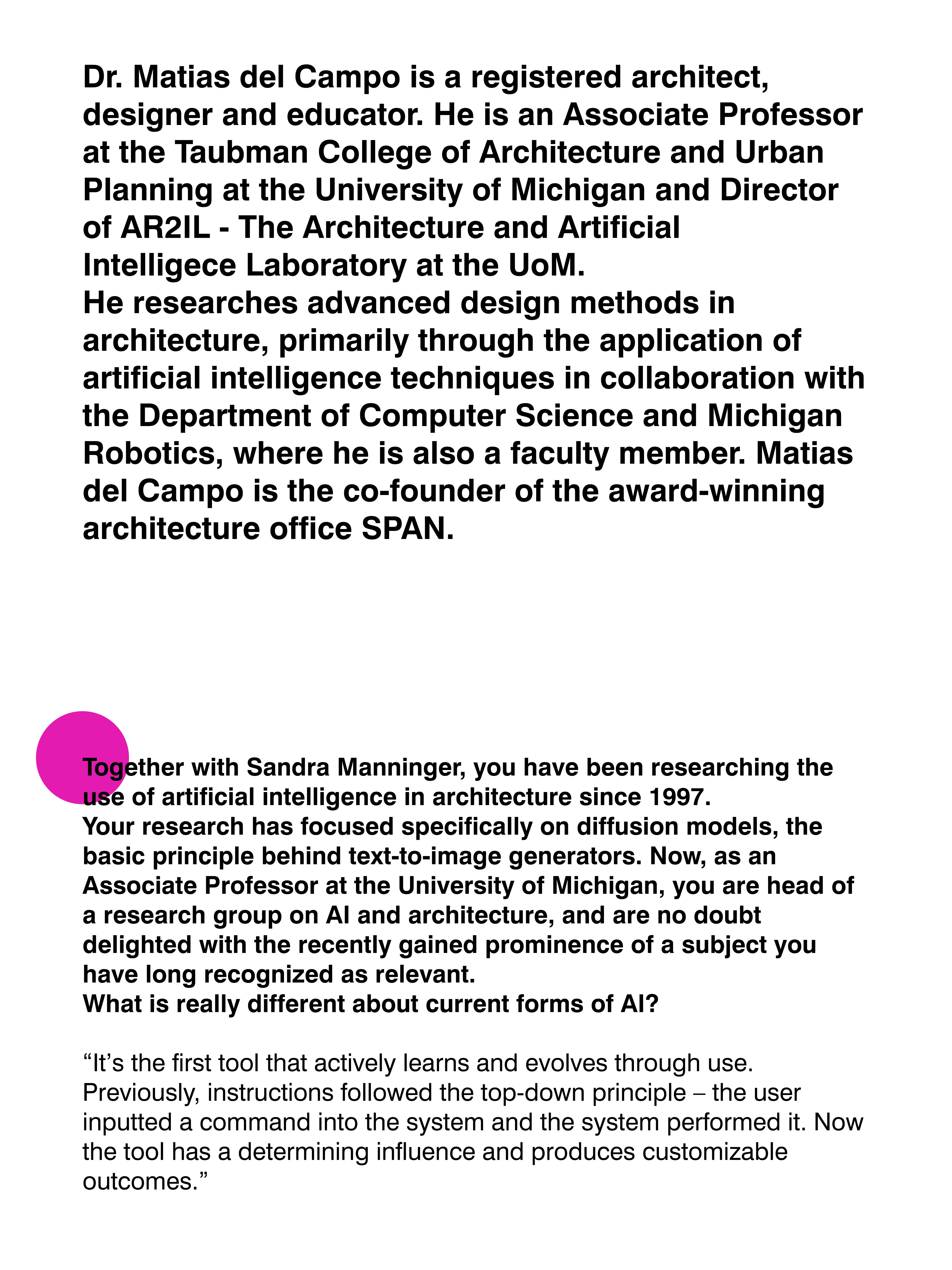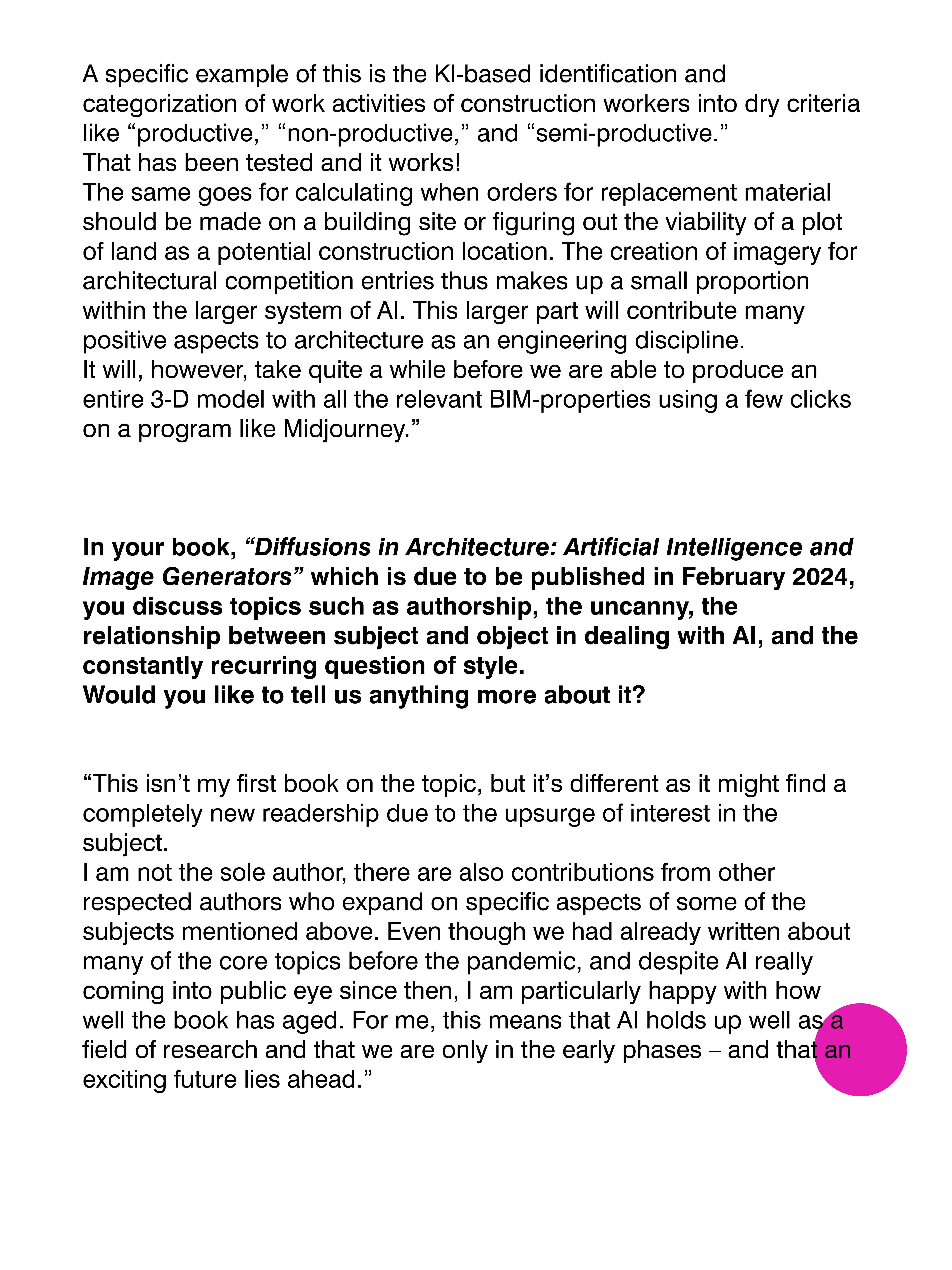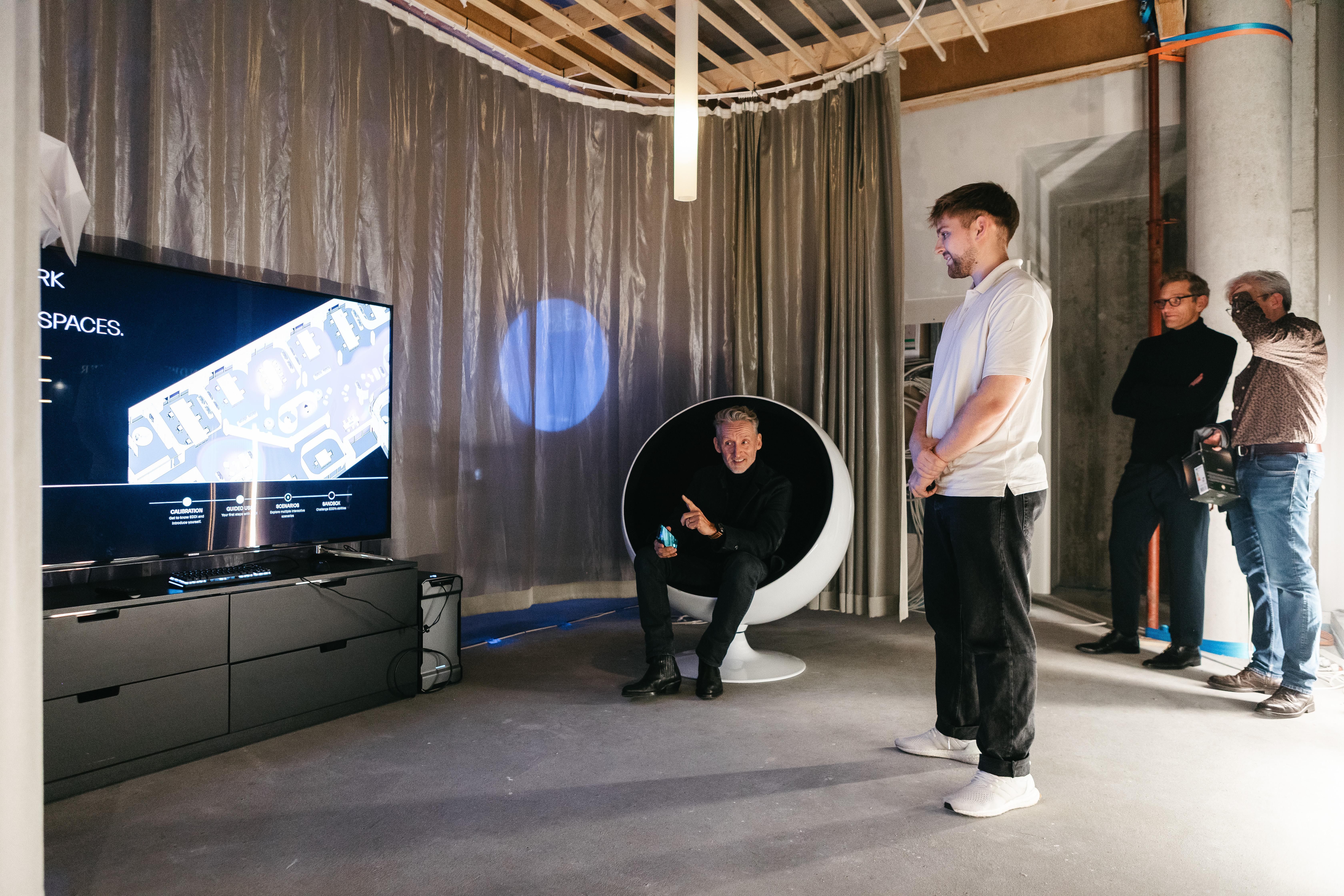
Artificial intelligence and architecture: From externalized imagination to physical implementation, AI technology will change daily working habits in the architectural world. What can this innovation, which is currently challenging human understanding, draw from the wealth of experience of architects, strategists, and designers? Which potentials can be reimagined – and how?
GRAFT presents an insight into the core issues of AI and extrapolates how they will influence the creative process in the foreseeable future.
Order the book "Diffusions in Architecture"
We view artificial intelligence...
… as an OPPORTUNITY:
Offering optimism and diversity
GRAFT has been using artificial intelligence in many ways for approximately 1,5 years. On the one hand we are looking to refine and improve our text-based image generation; on the other we are training an in-house AI program called “EDDI” – based on OpenAI – to develop specific programming and analysis tools to apply to our work processes.
This journal entry features an abridged interview with Dr. Matias del Campo, whose research on AI and early digital design methods we have been following for a long time.
In order to better navigate between the reactionary reflexes of dystopian scaremongering and the libertarian euphoria of deregulationism, as an office guided by “pragmatic optimism” we feel compelled to seek the advice of a balanced group of experts. With every technological leap forward, it is essential to constantly scrutinize one’s own position on social and moral issues within the context of even more fluid processes.
The narrative source material and scenographic depth of the AI-images generated in our office display a high level of complexity and an increasingly reduced processing time, something that will add a new dimension to the world of architecture. Architecture is teamwork and is therefore a process shaped by the many different databases, brains, and propensities of those involved. In our office, “serendipity effects” contribute as much to morphogenesis as intentional parameters. The changes brought about by artificial intelligence, however, will be swift and far-reaching; compared to the digital revolution of the last 30 years, the approaching period will represent a quantum leap. And everyone will have to react accordingly.
As a “progress-friendly” office, we will approach the doubtless negative prognoses about the AI revolution with an optimistic outlook. Knowledge and learning alone will ensure we aren’t left at the mercy of the changes we are currently witnessing. As these changes also offer opportunities, especially for smaller-scale budgets and work formats: Here, due to its low investment costs, AI enables the simulation of expensive work processes only previously available to highly profitable offices.
… as a DECODER OF MEANING:
Creating new criteria
Over the last months we have all been exposed to the sheer mass and contentual range of AI-generated images. In this period alone, the AI formats available to non-professional users have developed rapidly. Through AI, many people who didn’t previously consider themselves creative authors due to the many years’ training necessary have now been empowered to actively participate in the creative production process.
Even in the early days of designing with digital tools, which GRAFT experienced firsthand through its founding period in the 1990s, after the initial, naïve experiments and the easily effected fascination with the excesses of parametric design, subsequent discussions about quality, intention, and measurability only emerged during the second stage. It will be a similar situation with AI. For us today, particularly in relation to time effectiveness, the feedback loop of AI tools is full of fortuities and unpredictable outcomes, but this will change to allow critical reflection. GRAFT consciously positions itself at the forefront of innovation and strives to learn about the new possibilities and requirements with an open yet critical mind. We are interested in the development of interfaces that integrate the “script culture” of recent decades, BIM processes and other digital routines into the new opportunities offered by AI tools. Dall E, Stable Diffusion, and Midjourney will continue to develop rapidly in the coming year. New players will appear, others will disappear. Being part of this future is at once a privilege, a responsibility, and a source of great excitement.
...as an AUTOMATED PRODUCTION SPACE: From text/image via 3-D to BIM (2021) and Automatized Product (2024)
In the last 19 months alone, the path from input text to image has become massively reduced and qualitatively improved for practical users. In the future it might be possible to go from text to 3-D model to BIM model within a few operational steps. The idea is that a building could literally be “conjured up” – from the text prompt through to its planning and realization. When AGI, artificial general intelligence, is developed enough to be marketable, we could see even greater levels of independence in the planning professions. In discussions among experts, however, the closure of such gaps in the planning process are viewed critically. It will likely be a long time before there is an AI-based closed planning cycle that can be held liable by clients and insurance companies and considered eligible for loans from banks. Although it might soon be possible to decouple individual steps from slower manual processes.
… as a GENIUS LOCI:
Statistics, environmental criteria –
details, pragmatism, realities, functions, costs, BSE, etc.
For us, the genius loci is the fundamental starting point of every architectural creation. The use of computer-aided design in recent decades has facilitated an improved mastery of larger, more complex data sets, multiple technical and parametric factors, and a more profound integration of interdisciplinary factors from other specialist fields of planning. Given these tools, the architect – as an intuitive and rational author – has been able to process more information and generate more intelligent “architectural answers.”
These factors can already be performed automatically by specially trained artificial intelligence programs and incorporated into the morphogenesis of architecture. AI can process far more input material with a higher degree of complexity than a human counterpart when determining a genius loci. In the future, it will be possible to adapt entire designs to completely different environmental conditions in faraway locations at the touch of a button. At a time when economic constraints are stimulating discussions about serial prefabrication and large-scale modular construction once again, AI will hopefully be able to contribute to enhance the aesthetic simplicity and anonymous non-identity of such products. In this way, GRAFT is seeking to better reconcile economic restrictions with a more exacting building culture than the attempts seen in serial construction methods of recent years. Here, AI can help us “crack the code” in finding new avenues to do this.
… as an INTENTION RANDOMIZER:
Work–play, reverse processing
Text-based AI image generators have been incorporated into work processes in the world of architecture for some time now. In the beginning, the excitement was mainly characterized by the random experiences of a pioneering experimental spirit. Now, however, there are increasing calls for more controllability and manageability of user intent. This is where the next developments will be. It is already possible to load one’s own sketches and import images, entire 3-D files, or other source material, but the interface for manipulative tools, which can emphasize the user’s intention and increase control, are still at the primitive level of the first versions of Photoshop from the 1990s.
The difference between experimenting with an impressive range of possibilities and working on a creative project will start to rapidly shift. The playful nature of today’s AI work, characterized by automated random outcomes, has a low user threshold, which explains the steep growth curve in user numbers since mid-2022. At the next stage of its development, the personal skill of the “operator” will become more apparent, and individual authorship will become more recognizable. AI can only “remember”: it only draws on data sets of already existing designs and doesn’t invent anything new. In addition to discussions regarding copyright and remuneration, most notably there is a boundary between human and machine that won’t be crossed for quite some time.
...as STYLE
"in the style of" generates new
Authors, hybrids
AI-generated images are available in all known styles and rendering techniques. Because of its database-reliant mode of operation, AI can simulate any desired output style for the requested images. A masterful design “in the style of” Kengo Kuma or Karl Friedrich Schinkel, an expressive rendering “in the style of” Edward Hopper and voilà, the human–machine hybrid outcome is incorporated into a collective giga-brain – a way to liberate creativity from the idea of the ego. Thus, the prompt “in the style of” is currently one of the most frequently used input terms on Midjourney. AI allows us to superimpose a borrowed identity or a trademark signature in a matter of seconds. In hybridizing different spheres of reference, these stolen authorships in turn give rise to new stylistic worlds. As far back as 1998, Christoph Körner, GRAFT founding partner and today professor in Los Angeles, worked on a project at the UCLA called “Genetic Bastards,” a participative, user-controlled mixture based on stylistic architectural source codes.
Some creative professions, such as that of the photographer, have been able to protect themselves relatively well against unauthorized use of their material since the onset of digitization. Through streaming services, musicians have also been able to guarantee a certain, albeit significantly smaller, degree of security. At the very end of the chain are professions like that of the translator, whose knowledge has been rendered (almost) completely redundant by the availability of highly advanced translation software, so much so that many struggle to make a living from their work. Against this background, architects will have to redefine their unique, non-replaceable nature as authors. This must be achieved through a combination of rule-based protection through governance and the competitive betterment of individual talent.
… as SCRUTINY and VALUE:
Legislation, globalization–regionalism, democratic-freedom
Who does this giga-machine belong to? Who is willing to take responsibility for the fossil-based energy required to power it? And who will assume ethical responsibility for a globalized system that stores so much knowledge? Will there be billions of small, specialized neural networks governed by different nations, or will giga-companies be able to sell, regulate and control their products? Who will have a say in this? Will there be an opt-out system, or will we see trends such as “analog natives” that nostalgically romanticize an artificially imitated humankind? Such questions about responsibility are imminent, but as yet we have no satisfactory answers to them. As end-users we are not blameless: we are facilitating AI programs and their owners to develop and train them. We are complicit in a technology we don’t fully understand, and whose potential and risks we are unable to comprehend.
Still, there can’t be a full transfer of responsibility, only a constant awareness of the emerging dangers. In this respect, the desire to live a life of creativity is inevitably bound with making mistakes.
...as DEVELOPER:
Operator, user
IT jobs have proliferated over recent decades and are becoming increasingly well paid. Will mastering AI make architects into skilled programmers and remove themfrom the core function of being an architect? Architecture is still a real art form that finds its expression in the real, built world, where it must also prove its utility. Therefore, compared to many other professions that only focus on conceptual aspects, it isn’t possible to decouple architecture from the material world.
SUMMARY:
Navigating a responsible yet positive relationship between revolutionary technology and being human.
As creatives, coaches, and facilitators, we are translators operating between the inspirational interface of generative AI and the built world. With our expertise in architecture, branding, and work environments, we configure and train AI systems for specific applications and brands. In doing so, we address the question of how the relationship between people and disruptive technology can be configured in a more sustainable, humanistic way. This enables us to get a feel for how, when, and where we want to open ourselves up to the – sometimes controversial – innovation opportunities of large tech and AI companies. For us it’s clear: It takes personality, empathy, verve, and tangible added value.
With the “Cognizant Workplace” we are testing the potential of dialog-based spatial configuration within the work environment. EDDI, our artificial intelligence, plays the primary role in this. An AI with its own personality, it can adapt the environment to the needs of people working in real time – based on natural dialog, free listening and speaking, as well as calendar entries. EDDI’s training is devised in such a way that the focus is always directed towards productive cooperation and increasing employee satisfaction. It ensures that the work environment adapts to people, not the other way round.
As a “Cognizant Workplace,” the neural network “EDDI”* will offer the following qualities in the future:
- Personality
- Empathy
- A willingness to help
- Resolution: Solutions for conflicts of interest
- The dynamic configuration of spaces, taking into account criteria for smart buildings and Home 2.0
*The "Cognizant Workspace" is a concept by Nik Hafermaas, in collaboration with Dr.-Ing Detlev Herbst and Paul Herbst from herbst.design (EDDI Software)
For more information on AI methods: Baunetz interview with Wolfram Putz

























